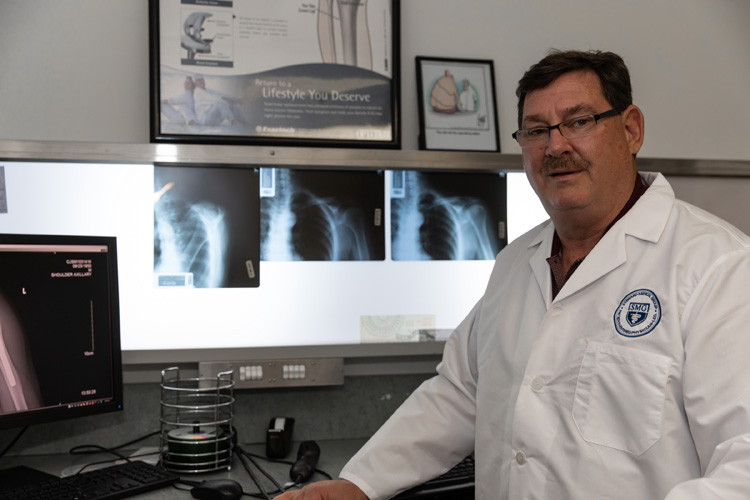
The American Academy of Orthopaedic Surgeons calls the shoulder joint “the most flexible joint in your body. Its ball-and-socket design allows you to place and rotate your arm in many positions in front, above, to the side and behind your body,” but the AAOS also warns that very flexibility is what makes the shoulder susceptible to instability and injury.
In fact, when that ball and socket joint isn’t functioning properly, it can feel more like a ball and chain, causing a severely limited range of motion and debilitating pain.
Fortunately, Dr. Kirk Maes, a board-certified orthopedic surgeon with Coastal Joint and Sports Medicine and the Steward Medical Group, is on hand to help.
“I trained as a shoulder specialist,” says Maes, “so I’ve just been attracted to that kind of work over the years.”
Maes also performs hip and knee replacement procedures, doing “about the same number of shoulder replacements as hip replacements.”
Since the shoulder – unlike the hip or knee – is not a weight-bearing joint, what causes it to fail?
Age is one factor. Degenerative joint diseases such as osteoarthritis and rheumatoid arthritis can play a role, as can rotator cuff tears or failed previous attempts to repair the rotator cuff, and the Mayo Clinic adds “if you have diabetes, you’re at increased risk due to diabetic neuropathy nerve damage and arterial disease.”
The rotator cuff is a group of muscles and tendons that surround the shoulder joint to keep the head of the upper arm bone firmly within the shallow socket of the shoulder.
“Ten or 15 years ago,” Maes explains, “we didn’t have shoulder replacements [prosthetics] that could accommodate a patient that didn’t have a rotator cuff that worked anymore.”
Today it’s a different story.
Maes points to “the smart biomedical engineers” who devised what’s called “reverse shoulder replacements.”
The major difference between a standard shoulder replacement and a reverse one is that in a reverse shoulder replacement, the ball and socket parts of the shoulder joint switch sides. Their natural position is reversed.
A prosthetic ball is placed on the socket side of the joint, the opposite or “reverse” of where it is in nature, and a prosthetic socket is then placed on the arm side where it is supported by a metal stem in the arm bone or humerus.
“Those bioengineers,” Maes continues, “pieced together that if you put the ball where the socket used to be and put the socket where the ball used to be, just mechanically, that makes the shoulder work so much better. You don’t need a rotator cuff. So, that’s kind of clever because one of the problems over the last 20 years in orthopedic surgery was what to do with a patient that didn’t have a rotator cuff anymore, who was 75 years old and couldn’t lift their arm. And we now have really good solutions for that.”
Johns Hopkins Medicine agrees.
It says “the main reason to consider a reverse prosthesis is when there is arthritis of the shoulder joint and the rotator cuff tendons are torn or gone. In this situation, this reverse operation will give the patient significant pain relief and also help with range of motion of the shoulder.”
As the AAOS states, “a reverse total shoulder replacement works better for people with cuff tear arthropathy because it relies on different muscles to move the arm.” Specifically, the larger, more powerful deltoid muscle.
“About 80 percent of the people that I give a reverse shoulder replacement to end up with no pain and as good a range of motion as they’ve ever had in their life,” says Maes.
“Maybe they can’t quite reach around their back as easily but they can get to the belt loops on the back of [their pants] and most people ultimately can lift overhead and reach well above eye level to get things out of the kitchen cabinets.
“Not everybody gets as robust of a result, but well more than three-quarters of the people are incredibly happy with their [reverse] shoulder replacement and it gives them remarkably good motion and strength to function.”
Maes credits a Florida company, Exactech in Gainesville, as “the fastest-growing, most popular shoulder replacement [prosthetic manufacturer] in the world,” and says he uses their products because they have “some of the smartest shoulder replacement surgeons in the world,” working with them.
“My job,” Maes concludes, “is to keep you going. Sometimes that requires a fancy shoulder replacement, but the goal is to keep people as active and busy as they want to be.”
Dr. Kirk Maes is with Coastal Joint and Sports Medicine and the Steward Medical Group. His offices are at 13000 U.S. 1 in Sebastian. The phone number is 772-581-5881.



